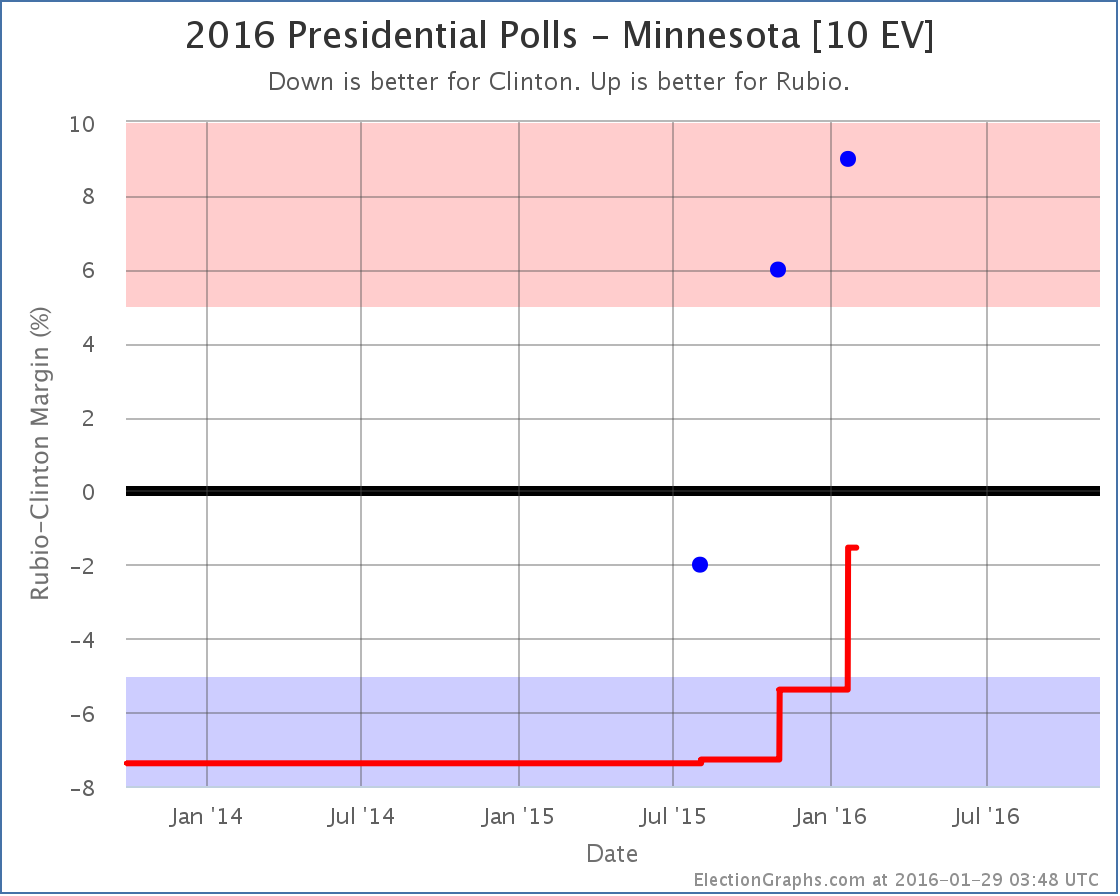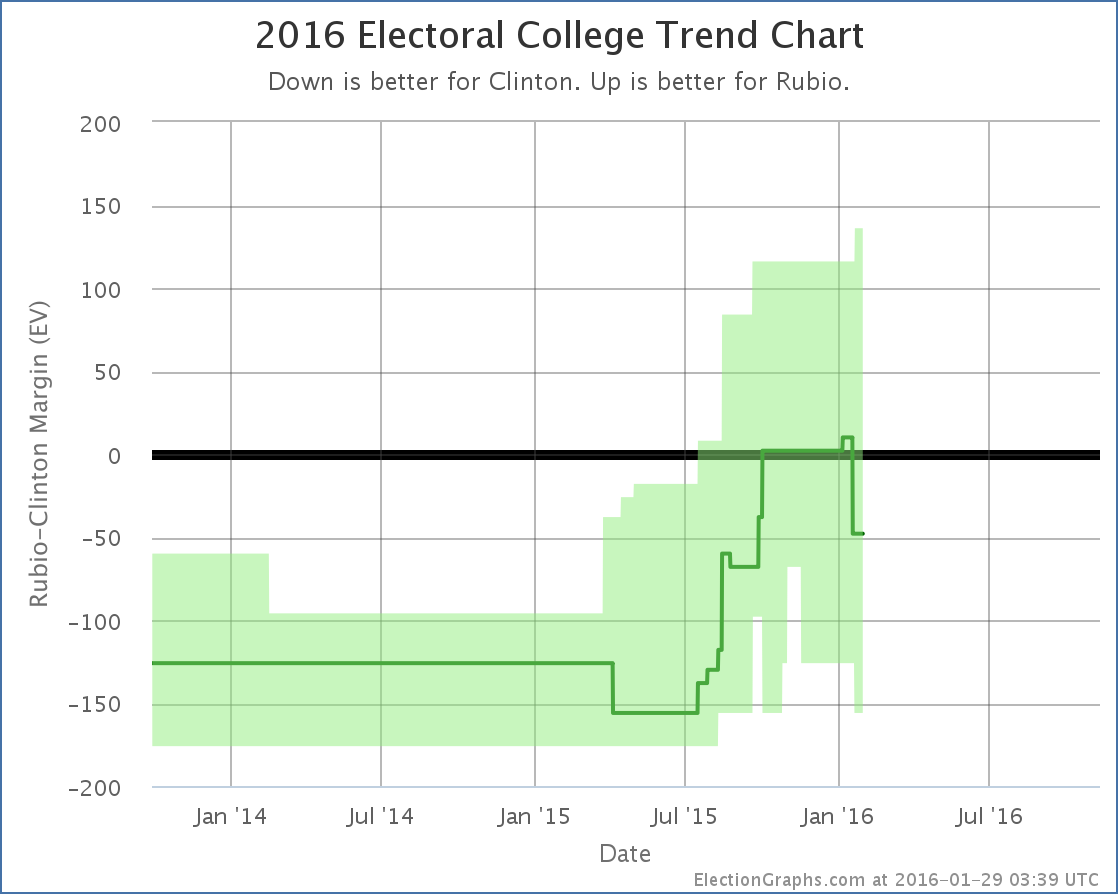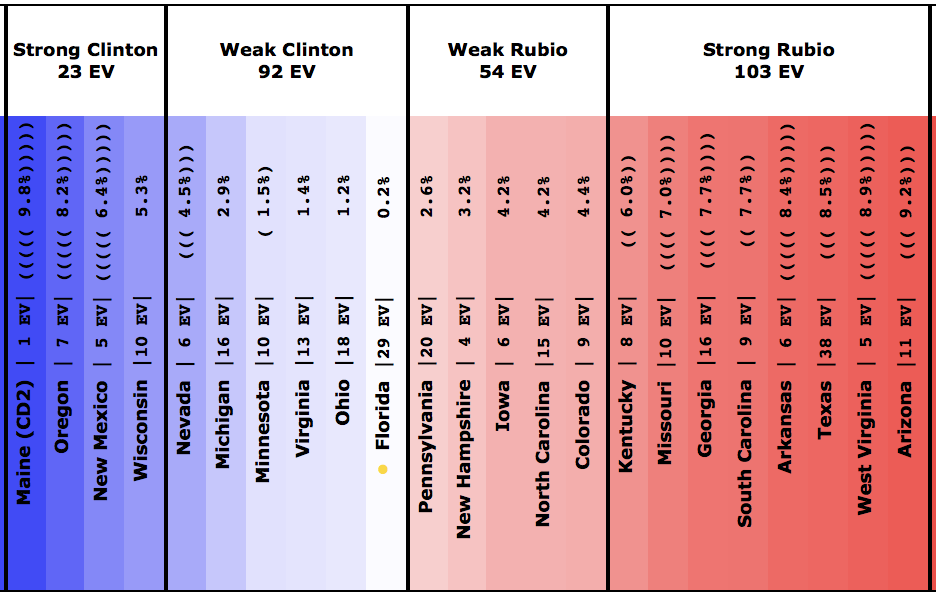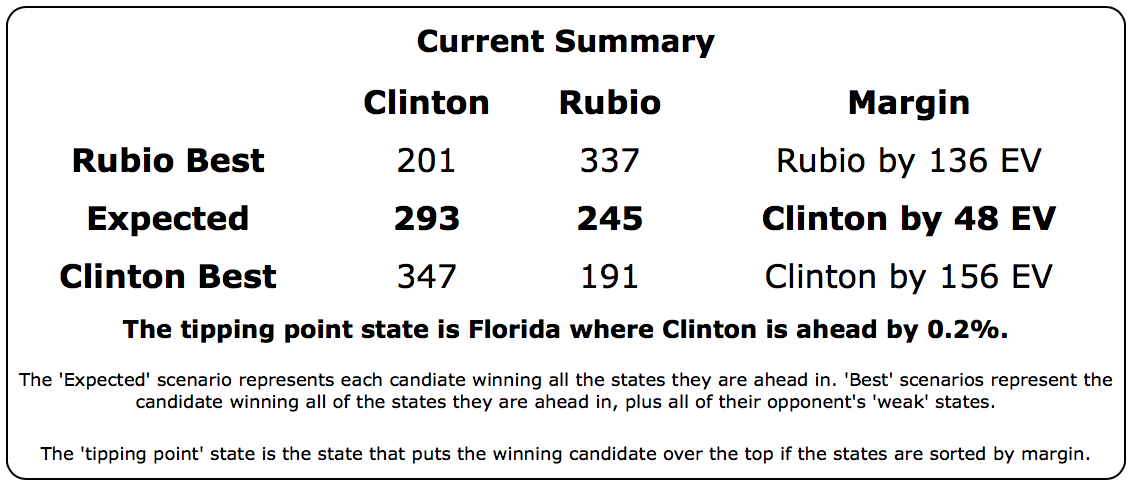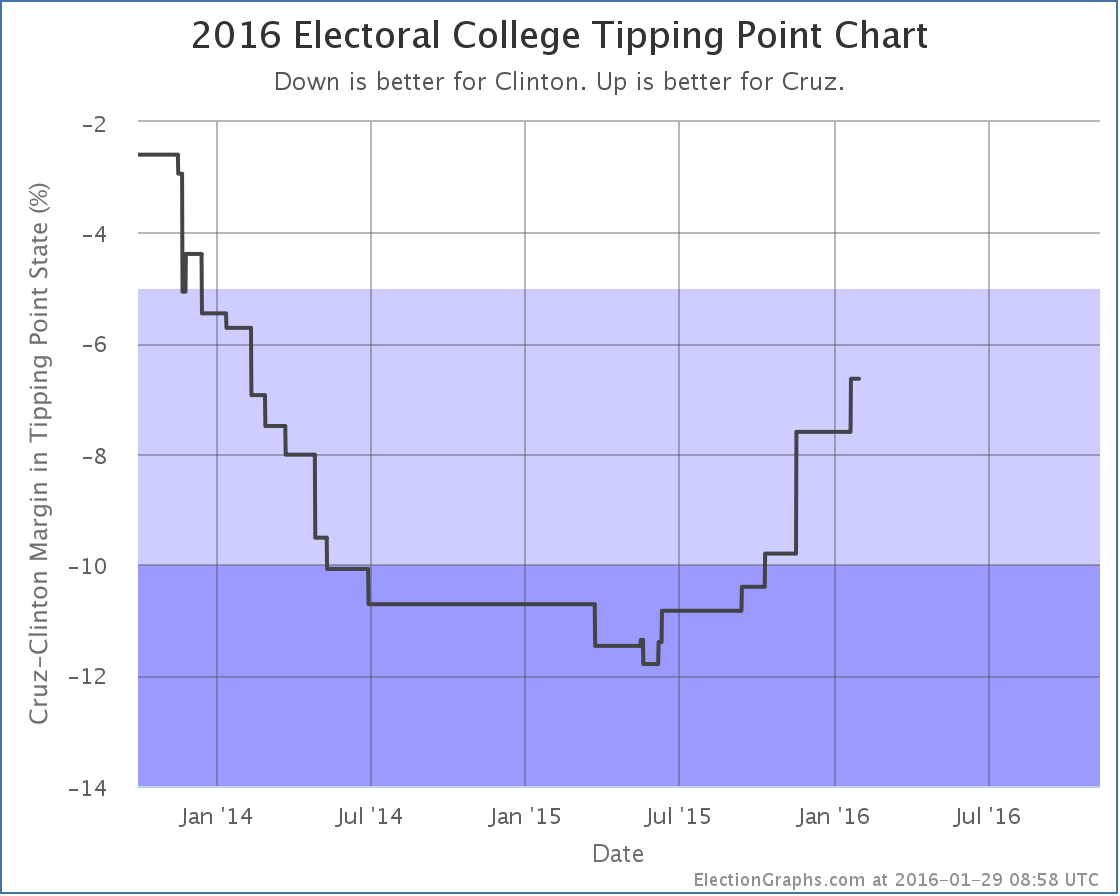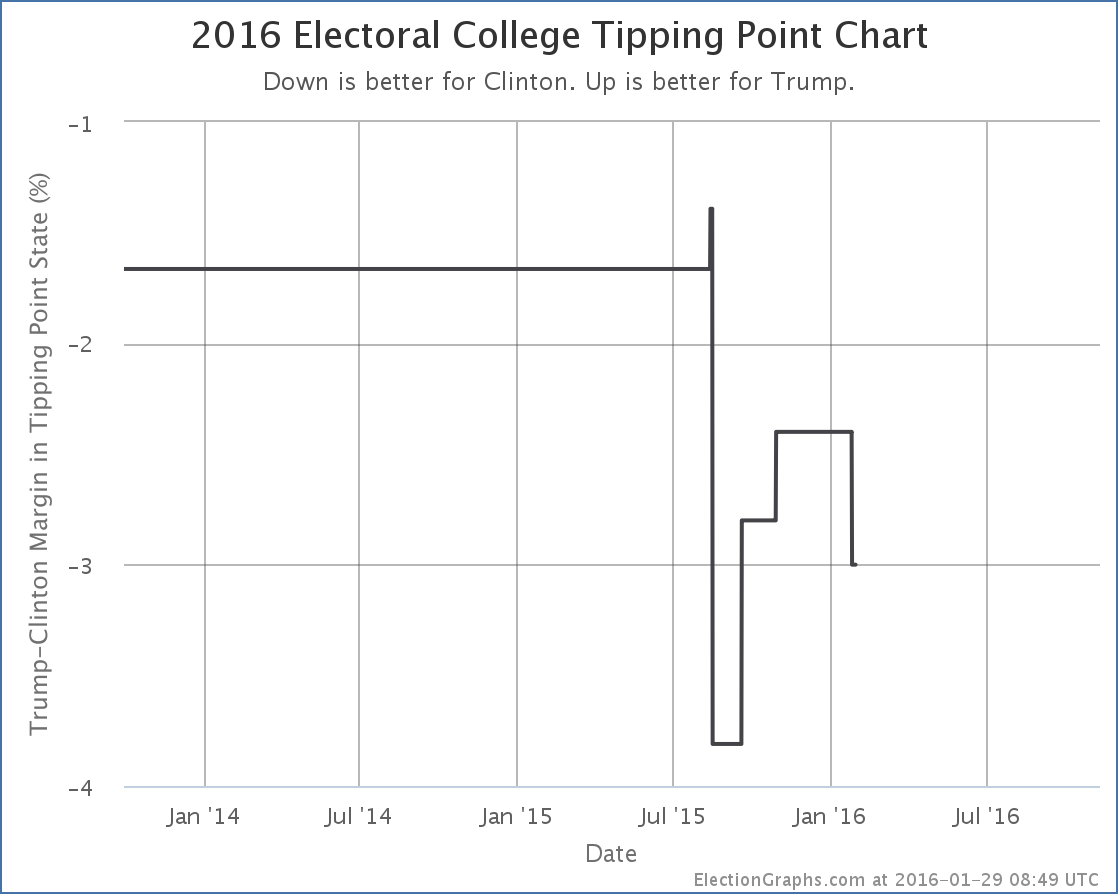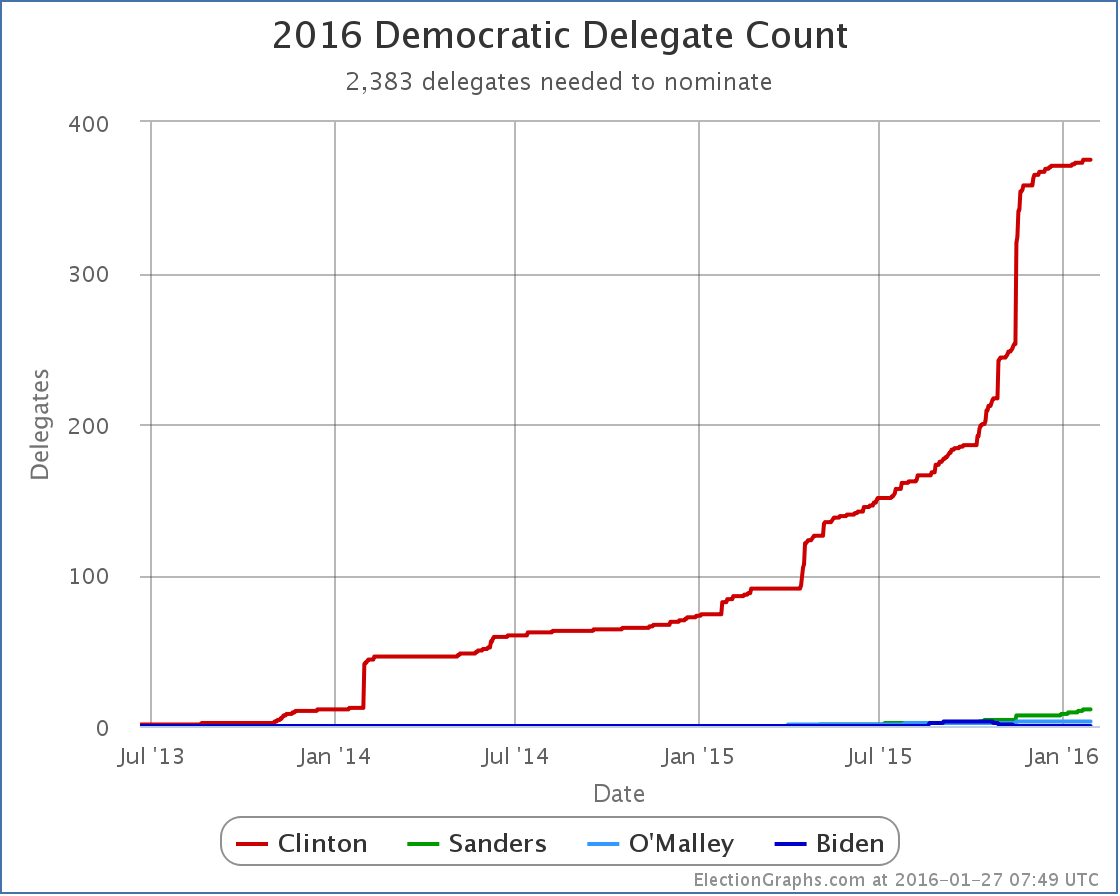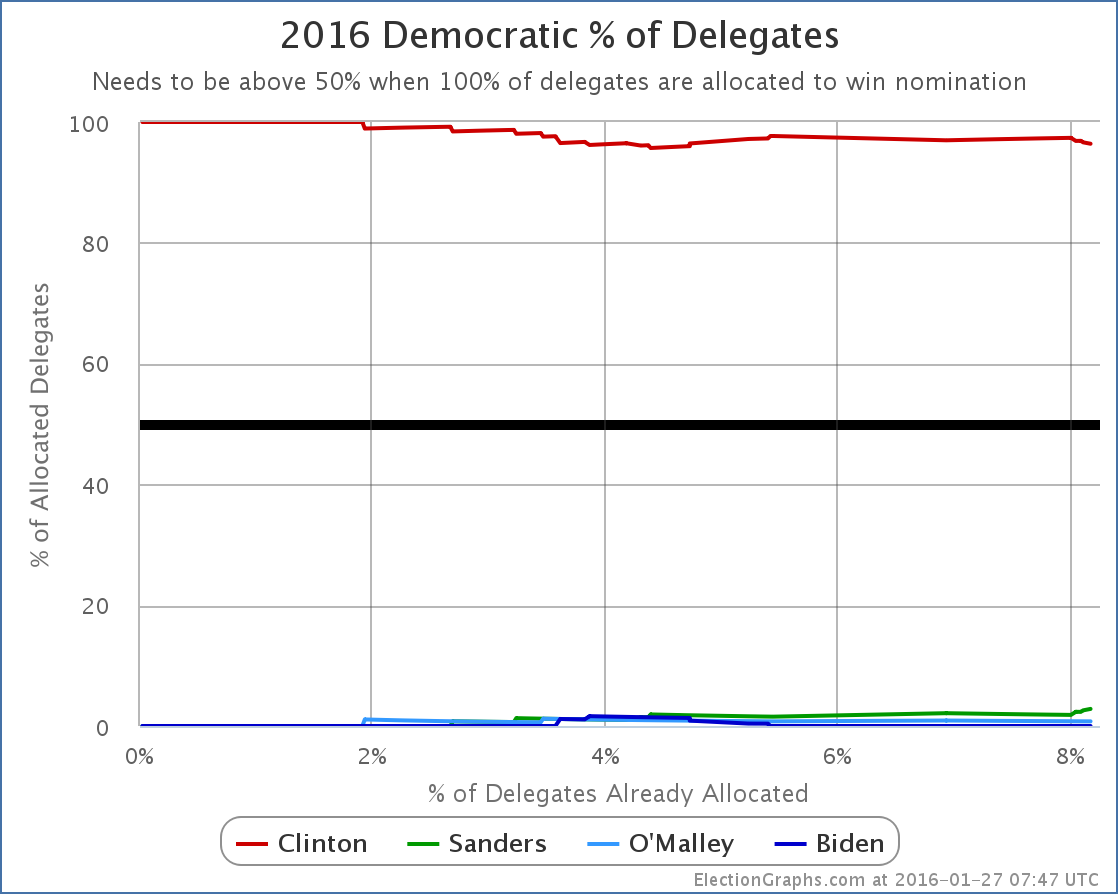- 15:07:24 A few new superdels since my delegates post. I’m not making new post 4 that tho. If you want to see the info, look over at @ElectionGraphs.
With just a few days until Iowa, the concentration is naturally on the delegate races, but general election polling continues as well. Until we have actual delegate counts, we’re still following changes for the five best polled candidate combination. With the newest batch of polls, we have two of the Republicans strengthening their position against Clinton in Minnesota. Clinton vs Rubio There hasn’t been a lot of polling in Minnesota, but what there is has been tilted further toward the Republicans than the five election average I use as a starting point for my poll averages. With the latest poll, the average moves to a Clinton lead of only 1.5%. This makes Minnesota start looking like a pretty close state. It makes Minnesota a possible pick up for Rubio, and therefore improves his “best case” against Clinton: What’s remarkable looking at Clinton vs Rubio at this point is the huge number of close states. There are 146 electoral votes in the “up for grabs” category, where the polling margin is under 5% and it would be very easy to imagine the state going either way. Add to that that the tipping point is only a 0.2% Clinton lead, and Clinton vs Rubio is the most evenly matched of the five best polled candidate combinations by a decent margin. The race is very close, and the “best cases” for the two candidates are relatively close to being symmetric. If the Republican race was about picking the candidate most likely to beat Clinton, Rubio would be way ahead. But it isn’t, and he isn’t. Clinton vs Cruz
Cruz improved in Minnesota from being behind Clinton by 8.8%, to only being behind by 6.3%. This did not result in a category change, but it did move the tipping point… the state that puts the winning candidate over the edge if you put the states in order. We go from the tipping point being Virginia with a 7.6% Clinton lead, to being Florida with a 6.6% Clinton lead. This still means Cruz is very far behind. He is clearly losing to Clinton. It isn’t particularly close. But it is closer than it was. Cruz has been consistently improving on this metric since June. If Cruz stays in contention in the primaries, watch this number to see if this trend continues and Cruz starts making it an actually competitive race, or if Clinton vs Cruz continues to look like an easy Clinton win. Clinton vs Trump OK, technically Clinton vs Trump is #6 in terms of how well polled the candidate combination is, which means by my rules I wouldn’t be talking about it right now. But given Trump’s position in the polls, I’ll mention it anyway. New Clinton vs Trump polling in Michigan (not in Minnesota like the other two) increases Clinton’s lead from 2.4% to 3.0%. This does not move Michigan to a new category, but it does move the tipping point. In this case the tipping state was and still is Michigan, so the tipping margin just moves from 2.4% to 3.0%. There isn’t enough here to declare a real trend. And both 2.4% and 3.0% are “close”. So either way, a Clinton vs Trump race is one with a small Clinton advantage, but still a race that could go either way. In just a few more days, we’ll have actual delegate leaders in both parties. Things are moving fast. 284.6 days until polls start to close on Election Day 2016. Note: This post is an update based on the data on ElectionGraphs.com. Election Graphs tracks both a poll based estimate of the Electoral College and a numbers based look at the Delegate Races. All of the charts and graphs seen in this post are from that site. Additional graphs, charts and raw data can be found there. All charts above are clickable to go to the current version of the detail page the chart is from, which may contain more up to date information than the snapshots on this page, which were current as of the time of this post. Follow @ElectionGraphs on Twitter or like Election Graphs on Facebook to see announcements of updates or to join the conversation. For those interested in individual general election poll updates, follow @ElecCollPolls on Twitter for all the polls as they are added.
The Election Graphs delegate tracker is live! In the last few hours I have posted an intro to this effort, a tour of the new features, and a FAQ. But now it is time to get into the meat of things and start talking about results and what they mean. While the Republican Party does have unbound delegates that will be able to make up their own minds independently, most of those people won’t be officially chosen until the primary/caucus season is well underway, and regardless, I haven’t yet found a good source of information tracking which of these folks is publicly supporting which Republican candidate. So the flow of delegate information for the Republicans won’t start until we get the results of the Iowa caucuses next week. But on the Democratic side… most of the “superdelegates” are already known (although some may change before the convention). The superdelegates are Governors, Senators, Representatives, members of the Democratic National Committee, and “Distinguished Party Leaders”. As Democratic activists, these people very often are quite public about who they support. And they show up in news reports when they do that. And there are places tracking it. Since this is the first analysis post of the primary season, I’m going to walk through the charts I use on my site, building up to the main one I believe is the one worth concentrating on going forward. If you just want to get straight to the punchline of how this race is going, skip to the last chart in the post and read from there. Since June of 2013, slowly but surely, the superdelegates have been publicly choosing sides… See the red line? That is Clinton. See the Green line? That is Sanders. Clinton is absolutely dominant here. By my best count, 389 of the 713 superdelegates have expressed a preference, and 375 of those have come out for Clinton. Sanders has 11. O’Malley 3. Now, the chart above is by date. It looks all jumpy because the delegates revealed their preferences at various random times, with a few big jumps when things happened, like Clinton officially announcing, or when AP did a survey of all the superdelegates. That can be interesting, but actually distorts the picture of how the race is coming along. Time to do a quick switch and show how this looks when we look at the % of delegates allocated instead of the date: Suddenly, we have nearly a straight line. The lumpiness caused by the uneven distribution of delegate preference announcements over time is gone and we get a much clearer look at what is happening. We see that over 8% of the delegates to the convention have already expressed a preference. Clinton has been consistently racking these up as they come in. She is dominating in this race. But by how much? Lets switch to looking at the % of delegates each candidate has… Once again we see that Clinton is dominant, but a few more details start to be seen. For instance we see that so far at least, Clinton’s weakest point was between the 4% and 5% marks when Biden, Sanders and O’Malley all had a few delegates in their columns and Clinton had about half the delegates she has today. But Biden dropped out, and Clinton kept on getting delegates at a pace not matched proportionately by Sanders or O’Malley, so Clinton’s dominant percentage increased again for awhile. Very recently though, at the tail end of this chart, you can see that Sanders has been collecting delegates at a fast enough pace that his percentage has actually been going up, while Clinton’s has been decreasing. The Sanders percentage is still small, but it is going up. So where does that put Sanders? How about his surge? Can he win? Time to look at the chart I consider to be the most important one to look at for understanding the race. Instead of looking at the percentage of delegates each candidate already has, we shift to looking at the percentage of the remaining delegates that the candidate would need to get in order to win the nomination: As Clinton racks up delegates, it becomes harder and harder to catch up. With the lead she already has based on superdelegates, in order to win, Sanders doesn’t need to get 50% of the remaining delegates, he needs to get 54.22% of the remaining delegates. Specifically looking at Iowa, 44 delegates are at stake. To be clear, no Democratic delegates will actually be earned on the night of the Iowa caucus. It is the first step of a multi-stage process that won’t end until June. But after the precinct caucus results next week, we’ll be able to make estimates based on the initial vote results and what we know about the specific delegate allocation rules in Iowa. With 44 delegates up for grabs, given the 54.22% number we calculated, for Sanders to actually put himself in a better position after Iowa than before, Sanders doesn’t need 22 or 23 delegates, he needs 24. Now, if Sanders gets more delegates than Clinton, the media and press coverage about the Sanders surge and the risk to Clinton will be overwhelmingly loud. Nobody other than this site will be talking about how he won, but didn’t get to 24, so he is actually worse off. Everything will be about the Sanders win and his “momentum”. And there is some fairness to this. If Sanders wins Iowa’s popular vote, no matter what the delegate estimates turn out to be, he will get a lot of positive attention. And people will talk about how Clinton is a lot weaker than she had seemed. That talk may improve Sanders’ position in New Hampshire or in other states further down the road. Perhaps it would boost him enough to compensate for the increase in the “% of remaining needed to win” that would result from falling short of 54.22% in Iowa. Getting a narrow win that doesn’t get enough delegates to actually improve the overall position in the short term may actually still have a positive impact in the medium to long run. Spin matters. The polls are close in Iowa, either Clinton or Sanders could easily take the state. But the numbers to watch are not the popular vote totals. You shouldn’t even be looking simply at who is estimated to get the most delegates. The question is if the person who gets the most delegates gets enough to be on pace to win. For someone other than Clinton to win, they have to start by catching up. This already means that they have to get more than 54% of delegates as we go forward. If they fail to reach that number, with each subsequent contest they will have to do even better to catch up. If they do reach that bar though, each subsequent contest becomes easier. That’s the way it works. But the target is not getting the most delegates in each contest. It is getting more than the number you need to be on pace to win. Right now Sanders needs 54.22% of the delegates. Clinton only needs 45.90% of the delegates. She doesn’t even need to get a majority since she has already banked so many delegates before voting even starts. So far, in the “invisible primary”, Clinton has scored an incredible 96.4% of the delegates. This will not continue. The Democratic leaders that make up the superdelegates have a very different perspective and background than Iowa caucus goers, or New Hampshire primary voters. Sanders will do better than the 2.8% of delegates he has managed so far. The question is how much better and if it puts him on track to actually catch up and win, or if it quickly becomes apparent that he is just playing the role of the protest candidate almost everyone originally expected him to be. If Sanders doesn’t get to that 54.22% mark in Iowa, we may know pretty quickly that he is falling short, although if he wins in the popular vote, there will still be a crazy media circus for weeks. If he exceeds that mark though, then the media howling might actually be warranted. At least until South Carolina. South Carolina is a very different state than either Iowa and New Hampshire, and the picture might change dramatically again after that. But the next few weeks will be exciting almost any way the results go. And we haven’t even talked about the Republicans this time since there aren’t any delegates to look at quite yet. There will certainly be quite a bit of excitement on that side as well. Tune in here for all the twists and turns as this race shifts into high gear! Just under a week until Iowa. Hold on tight. Note: This post is an update based on the data on ElectionGraphs.com. Election Graphs tracks both a poll based estimate of the Electoral College and a numbers based look at the Delegate Races. All of the charts and graphs seen in this post are from that site. Additional graphs, charts and raw data can be found there. All charts above are clickable to go to the current version of the detail page the chart is from, which may contain more up to date information than the snapshots on this page, which were current as of the time of this post. Follow @ElectionGraphs on Twitter or like Election Graphs on Facebook to see announcements of updates or to join the conversation. For those interested in individual general election poll updates, follow @ElecCollPolls on Twitter for all the polls as they are added. [Edit 06:45 UTC to fix wording] [Edit 08:09 UTC to update graphs] [Edit 08:15 UTC to fix typo] [Edit 2016-02-02 06:03 UTC to change “Delegate Race” in title to “Democrats” in preparation for separating posts on the two races] This is a FAQ for the 2016 Delegate Race portion of ElectionGraphs.com. The FAQ for the Electoral College portion is here. Why are you doing this?
OK, what are those things?
Why are your delegate counts different than those at my favorite media outlet?
So are you some kind of expert in the delegate selection process to make these estimates?
OK, so what are those sources?
Doesn’t the fact some delegates can change their minds invalidate the “% of remaining delegates” metric?
Do you come at this with some sort of political bias?
How often is the data updated?
You’ve done this before?
This is awesome, I’d like to share this or mention it in my own online space, can I?
This sucks, what a waste of time, you are obviously just a shill for <insert candidate you don’t like>… How can I tell you how awful you are?
Note: This post is an update based on the data on ElectionGraphs.com. Election graphs tracks both a poll based estimate of the Electoral College and a numbers based look at the Delegate Races. All of the charts and graphs seen in this post are from that site. Additional graphs, charts and raw data can be found there. All charts above are clickable to go to the current version of the detail page the chart is from, which may contain more up to date information than the snapshots on this page, which were current as of the time of this post. Follow @ElectionGraphs on Twitter or like Election Graphs on Facebook to see announcements of updates or to join the conversation. For those interested in individual general election poll updates, follow @ElecCollPolls on Twitter for all the polls as they are added.
|
||
